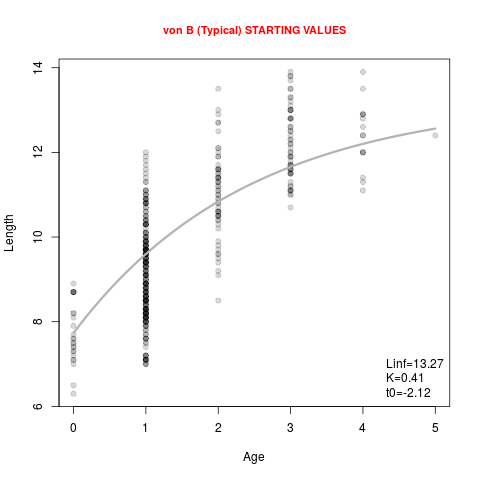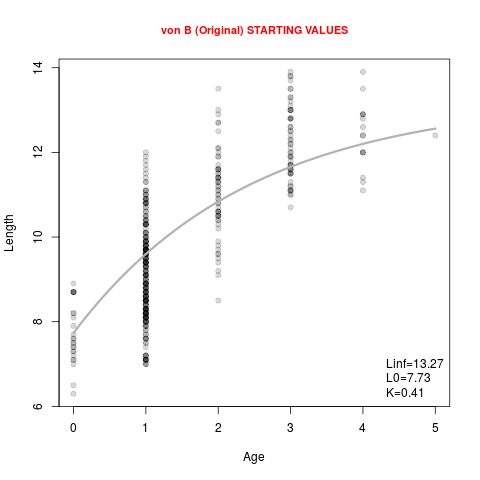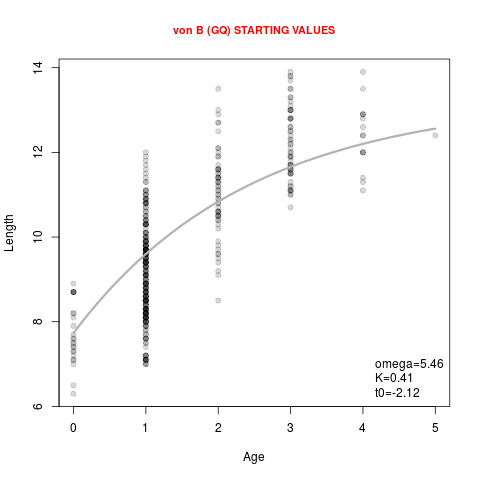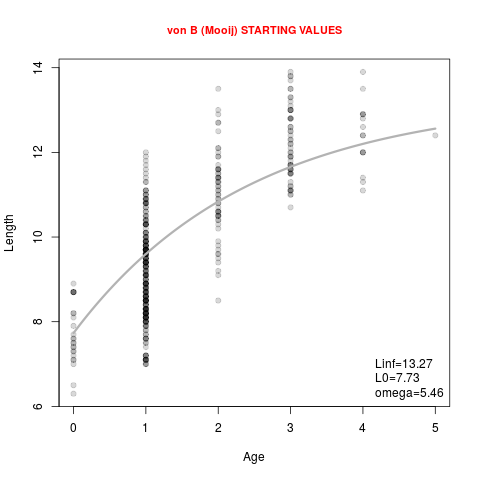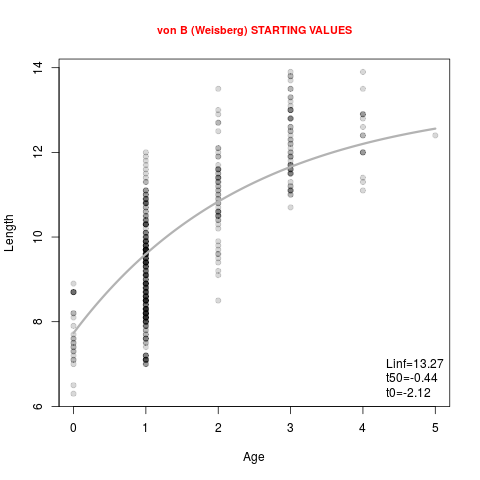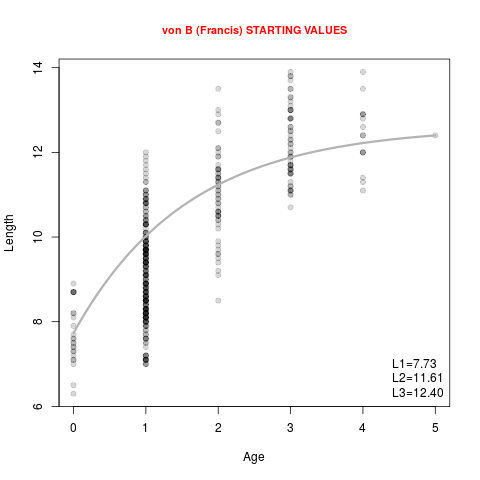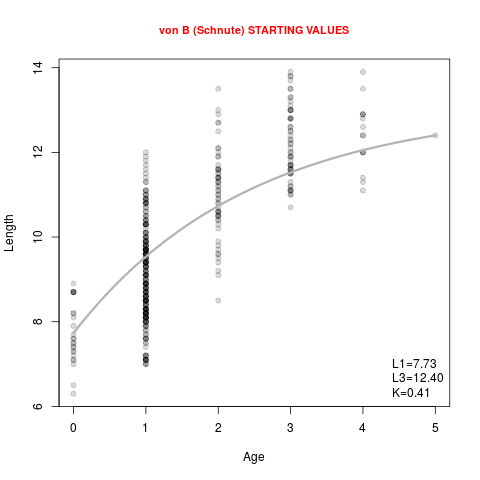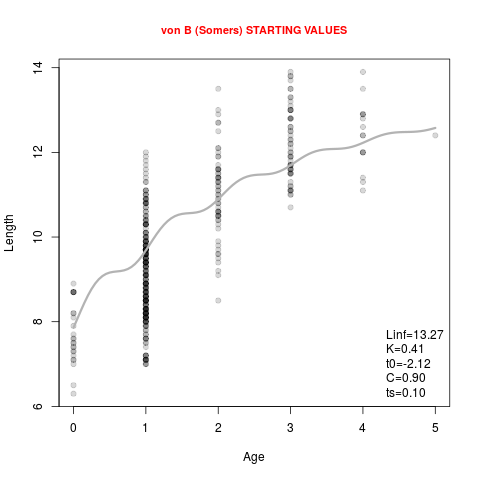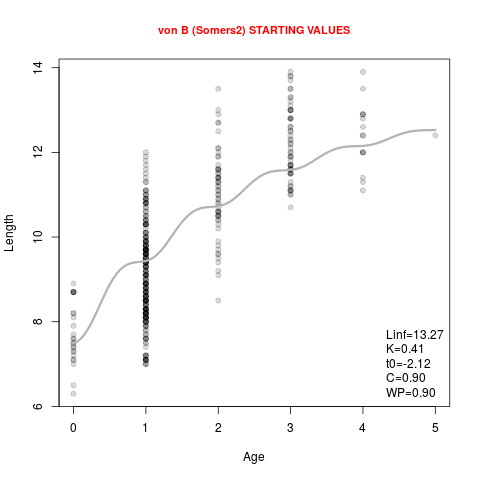Supported by Dr. Osamu Ogasawara and  providing providing  . . |
|
Last data update: 2014.03.03 |
Find reasonable starting values for a von Bertalanffy growth function.DescriptionFinds reasonable starting values for the parameters in a specific parameterization of the von Bertalanffy growth function. Usage
vbStarts(formula, data = NULL, param = c("Typical", "typical",
"Traditional", "traditional", "BevertonHolt", "Original", "original",
"vonBertalanffy", "GQ", "GallucciQuinn", "Mooij", "Weisberg", "Schnute",
"Francis", "Somers", "Somers2"), type = param, ages2use = NULL,
methEV = c("means", "poly"), meth0 = c("yngAge", "poly"), plot = FALSE,
col.mdl = "gray70", lwd.mdl = 3, lty.mdl = 1, cex.main = 0.9,
col.main = "red", dynamicPlot = FALSE, ...)
Arguments
DetailsThis function attempts to find reasonable starting values for a variety of parameterizations of the von Bertalanffy growth function. There is no guarantee that these starting values are the ‘best’ starting values. One should use them with caution and should perform sensitivity analyses to determine the impact of different starting values on the final model results. The Linf and K paramaters are estimated via the concept of the Ford-Walford plot. The product of the starting values for Linf and K is used as a starting value for omega in the GallucciQuinn and Mooij parameterizations. The result of log(2) divided by the starting value for K is used as the starting value for t50 in the Weisberg parameterization. If Starting values for the L1 and L3 parameters in the Schnute paramaterization and the L1, L2, and L3 parameters in the Francis parameterization may be found in two ways. If ValueA list that contains reasonable starting values. Note that the parameters will be listed in the same order and with the same names as listed in IFAR Chapter12-Individual Growth. NoteThe ‘original’ and ‘vonBertalanffy’ and the ‘typical’ and ‘BevertonHolt’ parameterizations are synonymous. Author(s)Derek H. Ogle, derek@derekogle.com ReferencesOgle, D.H. 2016. Introductory Fisheries Analyses with R. Chapman & Hall/CRC, Boca Raton, FL. See references in See AlsoSee Examples## Examples data(SpotVA1) vbStarts(tl~age,data=SpotVA1) vbStarts(tl~age,data=SpotVA1,type="Original") vbStarts(tl~age,data=SpotVA1,type="GQ") vbStarts(tl~age,data=SpotVA1,type="Mooij") vbStarts(tl~age,data=SpotVA1,type="Weisberg") vbStarts(tl~age,data=SpotVA1,type="Francis",ages2use=c(0,5)) vbStarts(tl~age,data=SpotVA1,type="Schnute",ages2use=c(0,5)) vbStarts(tl~age,data=SpotVA1,type="Somers") vbStarts(tl~age,data=SpotVA1,type="Somers2") ## Using a different method to find t0 and L0 vbStarts(tl~age,data=SpotVA1,meth0="yngAge") vbStarts(tl~age,data=SpotVA1,type="original",meth0="yngAge") ## Using a different method to find the L1, L2, and L3 vbStarts(tl~age,data=SpotVA1,type="Francis",ages2use=c(0,5),methEV="means") vbStarts(tl~age,data=SpotVA1,type="Schnute",ages2use=c(0,5),methEV="means") ## Example with a Plot vbStarts(tl~age,data=SpotVA1,plot=TRUE) vbStarts(tl~age,data=SpotVA1,type="original",plot=TRUE) vbStarts(tl~age,data=SpotVA1,type="GQ",plot=TRUE) vbStarts(tl~age,data=SpotVA1,type="Mooij",plot=TRUE) vbStarts(tl~age,data=SpotVA1,type="Weisberg",plot=TRUE) vbStarts(tl~age,data=SpotVA1,type="Francis",ages2use=c(0,5),plot=TRUE) vbStarts(tl~age,data=SpotVA1,type="Schnute",ages2use=c(0,5),plot=TRUE) vbStarts(tl~age,data=SpotVA1,type="Somers",plot=TRUE) vbStarts(tl~age,data=SpotVA1,type="Somers2",plot=TRUE) ## See examples in vbFuns() for use of vbStarts() when fitting Von B models Results
R version 3.3.1 (2016-06-21) -- "Bug in Your Hair"
Copyright (C) 2016 The R Foundation for Statistical Computing
Platform: x86_64-pc-linux-gnu (64-bit)
R is free software and comes with ABSOLUTELY NO WARRANTY.
You are welcome to redistribute it under certain conditions.
Type 'license()' or 'licence()' for distribution details.
R is a collaborative project with many contributors.
Type 'contributors()' for more information and
'citation()' on how to cite R or R packages in publications.
Type 'demo()' for some demos, 'help()' for on-line help, or
'help.start()' for an HTML browser interface to help.
Type 'q()' to quit R.
> library(FSA)
############################################
## FSA package, version 0.8.7 ##
## Derek H. Ogle, Northland College ##
## ##
## Run ?FSA for documentation. ##
## Run citation('FSA') for citation ... ##
## please cite if used in publication. ##
## ##
## See derekogle.com/fishR/ for more ##
## thorough analytical vignettes. ##
############################################
> png(filename="/home/ddbj/snapshot/RGM3/R_CC/result/FSA/vbStarts.Rd_%03d_medium.png", width=480, height=480)
> ### Name: vbStarts
> ### Title: Find reasonable starting values for a von Bertalanffy growth
> ### function.
> ### Aliases: vbStarts
> ### Keywords: manip
>
> ### ** Examples
>
> ## Examples
> data(SpotVA1)
> vbStarts(tl~age,data=SpotVA1)
$Linf
[1] 13.26773
$K
[1] 0.4114688
$t0
[1] -2.124367
> vbStarts(tl~age,data=SpotVA1,type="Original")
$Linf
[1] 13.26773
$L0
[1] 7.732
$K
[1] 0.4114688
> vbStarts(tl~age,data=SpotVA1,type="GQ")
$omega
[1] 5.459258
$K
[1] 0.4114688
$t0
[1] -2.124367
> vbStarts(tl~age,data=SpotVA1,type="Mooij")
$Linf
[1] 13.26773
$L0
[1] 7.732
$omega
[1] 5.459258
> vbStarts(tl~age,data=SpotVA1,type="Weisberg")
$Linf
[1] 13.26773
$t50
[1] -0.4397993
$t0
[1] -2.124367
> vbStarts(tl~age,data=SpotVA1,type="Francis",ages2use=c(0,5))
$L1
[1] 7.732
$L2
[1] 11.60785
$L3
[1] 12.4
> vbStarts(tl~age,data=SpotVA1,type="Schnute",ages2use=c(0,5))
$L1
[1] 7.732
$L3
[1] 12.4
$K
[1] 0.4114688
> vbStarts(tl~age,data=SpotVA1,type="Somers")
$Linf
[1] 13.26773
$K
[1] 0.4114688
$t0
[1] -2.124367
$C
[1] 0.9
$ts
[1] 0.1
> vbStarts(tl~age,data=SpotVA1,type="Somers2")
$Linf
[1] 13.26773
$K
[1] 0.4114688
$t0
[1] -2.124367
$C
[1] 0.9
$WP
[1] 0.9
>
> ## Using a different method to find t0 and L0
> vbStarts(tl~age,data=SpotVA1,meth0="yngAge")
$Linf
[1] 13.26773
$K
[1] 0.4114688
$t0
[1] -2.124367
> vbStarts(tl~age,data=SpotVA1,type="original",meth0="yngAge")
$Linf
[1] 13.26773
$L0
[1] 7.732
$K
[1] 0.4114688
>
> ## Using a different method to find the L1, L2, and L3
> vbStarts(tl~age,data=SpotVA1,type="Francis",ages2use=c(0,5),methEV="means")
$L1
[1] 7.732
$L2
[1] 11.60785
$L3
[1] 12.4
> vbStarts(tl~age,data=SpotVA1,type="Schnute",ages2use=c(0,5),methEV="means")
$L1
[1] 7.732
$L3
[1] 12.4
$K
[1] 0.4114688
>
> ## Example with a Plot
> vbStarts(tl~age,data=SpotVA1,plot=TRUE)
$Linf
[1] 13.26773
$K
[1] 0.4114688
$t0
[1] -2.124367
> vbStarts(tl~age,data=SpotVA1,type="original",plot=TRUE)
$Linf
[1] 13.26773
$L0
[1] 7.732
$K
[1] 0.4114688
> vbStarts(tl~age,data=SpotVA1,type="GQ",plot=TRUE)
$omega
[1] 5.459258
$K
[1] 0.4114688
$t0
[1] -2.124367
> vbStarts(tl~age,data=SpotVA1,type="Mooij",plot=TRUE)
$Linf
[1] 13.26773
$L0
[1] 7.732
$omega
[1] 5.459258
> vbStarts(tl~age,data=SpotVA1,type="Weisberg",plot=TRUE)
$Linf
[1] 13.26773
$t50
[1] -0.4397993
$t0
[1] -2.124367
> vbStarts(tl~age,data=SpotVA1,type="Francis",ages2use=c(0,5),plot=TRUE)
$L1
[1] 7.732
$L2
[1] 11.60785
$L3
[1] 12.4
> vbStarts(tl~age,data=SpotVA1,type="Schnute",ages2use=c(0,5),plot=TRUE)
$L1
[1] 7.732
$L3
[1] 12.4
$K
[1] 0.4114688
> vbStarts(tl~age,data=SpotVA1,type="Somers",plot=TRUE)
$Linf
[1] 13.26773
$K
[1] 0.4114688
$t0
[1] -2.124367
$C
[1] 0.9
$ts
[1] 0.1
> vbStarts(tl~age,data=SpotVA1,type="Somers2",plot=TRUE)
$Linf
[1] 13.26773
$K
[1] 0.4114688
$t0
[1] -2.124367
$C
[1] 0.9
$WP
[1] 0.9
>
> ## See examples in vbFuns() for use of vbStarts() when fitting Von B models
>
>
>
>
>
>
> dev.off()
null device
1
>
|
